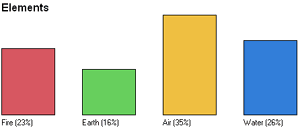
| What Watch? - Tutorial | Next chapter: Tablets | Back to First Page |
Search and Analysis
Who else has the Moon in Virgo? Are there many people in this group with the Sun in the 6th house? Is there an element or quality that is particularly prominent in a family?
Questions like these can be answered using the Search and Analysis modules of What Watch. However, there are some limitations. What Watch can work on any horoscope,
Charts imported from a Quick*Chart file do not contain the necessary information – and therefore are not searchable. They can be used one by one only. You can find the import and export functions of What Watch following the "Select Group" button.
Search charts
The Search module is located on the "Analysis" tab. On this panel, choose the "Search" tab that allows to search for those charts with a given planet in a given sign. Select
the Sun and Leo and press the button on the bottom left labelled "Search".

The resulting list contains at least the chart of Carl Gustav Jung, whose Sun is at 3°19 Leo (the charts of Jung and Freud are the two example charts that are part of What Watch). Click on "Load One" to load the chart into tab "One", or click "Load Two" to load into tab "Two".
Analyzing groups of charts
The Analysis module is also located on the "Analysis" tab. On this panel, choose the "Analyze" tab that gives information on the distribution of astrological markers within a
given group.
 |
Look at this example showing the distribution of elements among all planets in a group of 16 people. In this case, it's a family, whose dominant element is Air. You can refine this result by looking at the signs involved or show the decanates of the planets' positions. Any single or group of planets can be analyzed in the same way. |
What Watch can cope with many thousands of charts. The following example shows the Sun signs for 1.450 scientists from the database of the German Federation of Astrologers. Again, you can analyse decanates or house positions as well, for any single or group of planets.

This analysis was done by just counting planets. Each planet has the same importance, the Sun counts the same as Chiron. This mode is activated by chosing "Number" in the bottom listbox. The second option available there, "Weight", uses the planetary weights as defined on the preferences page. Here, by default, the Sun counts almost four times as much as Chiron. A placement of the Sun therefore influences the result far more than the same placement of Chiron. The weight of each planet can be changed by the user on the preferences page.
| What Watch? - Tutorial | Next chapter: Tablets | Back to First Page |